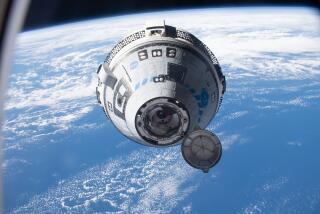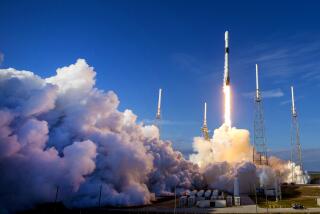Shuttle Rockets to Be Shipped to Florida Site
- Share via
HUNTSVILLE, Ala. — Rocket engineers expect to complete removal of a suspect “boot ring” and next month begin assembly of the booster rockets to launch the first space shuttle flight since the Challenger tragedy, NASA officials said Thursday.
Officials of the National Aeronautics and Space Administration’s Marshall Space Flight Center said the upper segments of the huge solid rockets will be shipped to their Florida launching site as early as next week, with the modified aft segments to follow, perhaps by mid-February.
Their comments followed a decision, expected to be approved by top NASA officials Saturday, to return to an earlier booster design, which does not include the eight-foot-diameter boot ring that failed in a December test firing.
Several members of a National Research Council panel monitoring NASA’s redesign of the booster took part in the conferences with NASA and Morton Thiokol Inc. officials in Utah earlier this week and were understood to have approved the strategy.
H. Guyford Stever, chairman of the NRC panel, was quoted as saying the return to the successfully tested earlier design is probably the way to go, noting that it was “the one area in which they had an alternative.”
The failure of a seal between segments of one of the shuttle’s solid booster rockets caused the Jan. 28, 1986, explosion of the Challenger above the coast of Florida.
History’s worst space accident claimed the lives of seven crew members, including Sharon Christa McAuliffe, a schoolteacher aboard as the first ordinary citizen to fly in space.
Further Delay Feared
The test mishap last month created a wave of speculation that the shuttle, already grounded two years, thus might face yet another long delay before its next launching.
But officials said Thursday that the launching of the shuttle Discovery could come in August, meaning a delay of as little as six weeks from its previously planned June launching.
More than a week after the discovery that a long segment of the boot ring had crumbled during the test, rocket experts still have not determined the cause.
Until the decision Wednesday to drop the design with the faulty boot ring, NASA had been pursuing two separate designs.
The first, tested in a two-minute firing last August, worked perfectly. But officials continued work on the second version with the boot ring, which failed in December, because they thought it was an improvement.
Protecting Bearings
The boot ring was added in the belief it would better protect the bearings in the mechanism that swivels the rocket nozzle and controls the direction of thrust.
It is not associated with the redesigned seals--commonly called O-rings--between the rocket segments and between the aft segment and the rocket nozzle.
Indeed, Royce Mitchell, director of the solid rocket motor program, Thursday expressed total confidence in the redesigned O-ring blamed for the Challenger catastrophe.
“The O-ring,” he said, “is now the least of my worries.”
Thompson said he believes the December failure--in which about half of the boot ring broke into small pieces--actually occurred an instant after the rocket stopped firing in the test, and, therefore, would have had no effect had it happened in flight.
“It looks as if it popped off after the test,” he said.
Inquiry to Continue
Efforts will continue to determine why the ring failed, although NASA will now cast its lot with the engine design that flawlessly passed its two-minute test firing in August.
Thompson said the suspicion is that the failure was caused by charring, sudden cooling and pressure changes that followed the rocket firing rather than by the vigorous swiveling of the engine nozzle during the test.
He called the return to the earlier design an “attractive option.”
In the next several weeks, engineers for NASA and Morton Thiokol will remove the nozzles from the two boosters that had been almost ready for shipment to Florida, and cut off the boot rings.
Two test firings of full-scale qualification motors will be carried out at the Thiokol plant outside Brigham City, Utah, in the spring--one in late March and one in late May.
The additional delay in the launching will also make it possible to carry out a “production verification” test before the flight.
Rocket to Be Fired
In that test, a rocket will be selected at random from those being readied for shipment, put in a test stand and fired without any changes being made in it.
If the launching had gone off as planned in early June, it would have been before such a production verification firing.
At the same time the breakdown of the boot ring was being studied in Utah this week, work on the production of shuttle booster segments was slowed by an investigation of the Dec. 29 rocket fuel explosion that killed five Thiokol workers. The tragedy occurred when solid fuel for the Air Force’s MX missile burst into flame at a site five miles from the test bay where the boot-ring engine had been tested a few days earlier.
In the wake of it, NASA undertook a safety review of the shuttle booster production plant.
More to Read
Sign up for Essential California
The most important California stories and recommendations in your inbox every morning.
You may occasionally receive promotional content from the Los Angeles Times.










